Hebrew: פרג אגסני, Arabic: الخشخاش الأبجر
| Scientific name: | Papaver umbonatum Boiss. | |
| Synonym name: | Papaver subpiriforme Fedde | |
| Common name: | Corn Poppy | |
| Hebrew name: | פרג אגסני | |
| Arabic name: | الخشخاش الأبجر | |
| Family: | Papaveraceae, פרגיים |
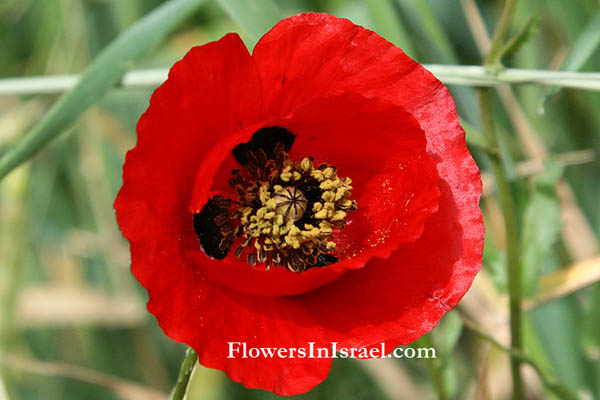
|
| Life form: | Annual | |
| Stems: | Hairy stems contain a latex or milky sap | |
| Leaves: | Alternate, rosette, dissected, dentate or serrate | |
| Flowers: | Red with black | |
| Fruits / pods: | Capsules erect; seeds many | |
| Flowering Period: | March, April, May | |
| Habitat: | Batha, Phrygana | |
| Distribution: | Mediterranean Woodlands and Shrublands, Semi-steppe shrublands, Montane vegetation of Mt. Hermon | |
| Chorotype: | Mediterranean | |
| Summer shedding: | Ephemeral |
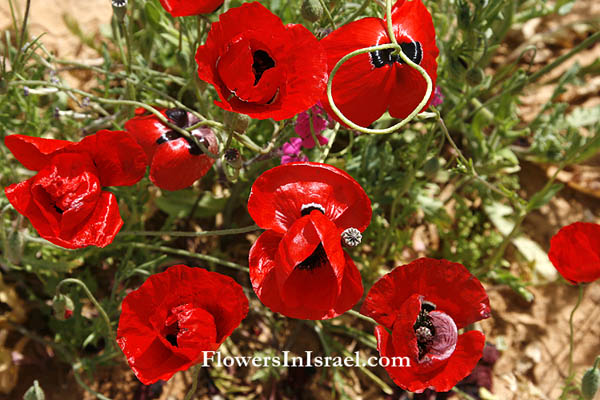
Derivation of the botanical name: Papaver, the classical Latin name for the poppy. umbonatum, having a rounded projection or umbo in the middle. subpiriforme, sub, partially; pyriformis, pear-shaped, obovoid or narrowly obovoid with a tapering base. Poppy, derived from the Old English popæg and referring to various species of Papaver. The Hebrew name: pereg, פרג (sometimes parag) derives from the Sanskrit word priyangu, meaning "foxtail millet" (or "panic seed".) . It is found in the plural - פרגין - in the Mishna (Sheviit 2:7, Chalah 1:4) and in the Talmud (Rosh Hashana 13b), listed together with other crops that aren't full grains like shumshum שומשום - sesame and orez אורז - rice.
The “Red Anemone Guild Flowers” comprises some of the species from six plant genera (Anemone, Tulipa, Ranunculus, Adonis, Glacium and Papaver) that belong to three phylogenetically distant families (Ranunculaceae, Liliaceae and Papaveraceae). Flowers of this guild are characterized by large, red bowl-shaped petals that surround a large black mass containing the anthers and the female reproductive organs. The flowers are insect-pollinated, and offer only pollen as food reward to visitors. The uniqueness of the red anemone guild species is due to the rarity of large red floral displays among the congeners of the guild members, as well as in the Mediterranean flora (Shmida 1981; Dafni & Shmida 1989). The pollination of the "Red Anemone Guild" is by Glaphyrid beetles (Scarabaeoidea) Three Sisters, an Israeli Fairy tale Once upon a time, in a far country, there lived a handsome prince. After years of dissipation and tumultuous bachelorhood the prince decided to take a woman in his life, and announced that he would give an evening of “Speed Dating”, free and open to the female audience. Hundreds of women decided to try their luck, including the Three Sisters: Anemone, Scarlet Crowfoot and Poppy. On the appointed day the sisters (like most invited) stormed the nearby mall to get the most up to date garment and the most impressive accessories. The mall was full of women pushing and shopping to get an outfit. Within minutes the sisters had lost each other and only met again when they returned to their homes, each with the result of her shopping frenzy, all with the same red dress. Trouble!? How could the Prince distinguish between the three? After the tears, the blood returned to their faces, and they found a solution: each of them would add a rather unique accessory to her red dress. Anemone added a white scarf she brought from her travels in India. Scarlet Crowfoot (Ranunculus), the trendy, added a green belt, decorated her dress with glitters and put on glossy lipstick. Poppy wore a black beaded necklace around her neck. With the upgraded performance they entered the hall and seized the prince's heart within minutes. He spent an entire day with every one of them, and after three days he admitted he could not reach a decision. The three sisters were also captured by the prince’s charms, and each wanted him for herself. Wow, and another solution was found: the Prince would marry the three of them, on condition that once a year, every year, he will dedicate a period of time with each one separately. The Prince in love quickly agreed, and only asked the sisters to continue to wear their special accessories to avoid unnecessary confusion and shame. For the same reason he also decided to open a log book and to set dates for each sister, in alphabetical order – Anemone, Scarlet Buttercup, Poppy. Since then, every year, Anemone is the first to bloom, with a white scarf around the stamens, Scarlet crowfoot with the bright shiny leaves and the typically green sepals enclosing the petals in the form of a belt, is the second to appear and Poppy finishes the cycle, with dark circles on the petals. So now you can distinguish the difference between an anemone and poppy. Scarlet corn poppies (papaver rhoeas) grow naturally in conditions of disturbed earth throughout Western Europe. The destruction brought by the Napoleonic wars of the early 19th Century transformed bare land into fields of blood red poppies, growing around the bodies of the fallen soldiers. In late 1914, the fields of Northern France and Flanders were once again ripped open as World War One raged through Europe's heart. Once the conflict was over the poppy was one of the only plants to grow on the otherwise barren battlefields. The significance of the poppy as a lasting memorial symbol to the fallen was realised by the Canadian surgeon John McCrae in his poem In Flanders Fields. The poppy came to represent the immeasurable sacrifice made by his comrades and quickly became a lasting memorial to those who died in World War One and later conflicts. It was adopted by The Royal British Legion as the symbol for their Poppy Appeal, in aid of those serving in the British Armed Forces, after its formation in 1921. In Flanders Fields By John McCrae, a Canadian physician and Lieutenant Colonel. He wrote it on 3 May 1915 after he witnessed the death of Lieutenant Alexis Helmer of Ottawa, who had been killed by a shell burst on 2 May 1915 (World War One). Between the crosses, row by row, That mark our place; and in the sky The larks, still bravely singing, fly Scarce heard among the guns below. We are the dead. Short days ago We lived, felt dawn, saw sunset glow, Loved, and were loved, and now we lie In Flanders fields. Take up our quarrel with the foe; To you from failing hands we throw The torch; be yours to hold it high. If yea break faith with us who die We shall not sleep, though poppies grow In Flanders fields. After John McCrae's poem In Flanders Fields was published in 1915 the poppy became a popular symbol for soldiers who died in battle. In 1918, Moira Michael, an American, wrote a poem in reply, That grows on fields where valor led, It seems to signal to the skies That blood of heroes never dies This began the tradition of wearing a poppy in remembrance. The British Remembrance Day - Poppy Day, is always held on the 11 November. This is the day that World War One ended in 1918, when the armistice was signed in Compiègne, Northern France. SEE: Helichrysum sanguineum, Red Everlasting, Red cudweed, a symbol for the Israeli Memorial Day for the Israeli Fallen Soldiers and the Victims of Terrorism, Yom Hazikaron, which falls in late April or May. 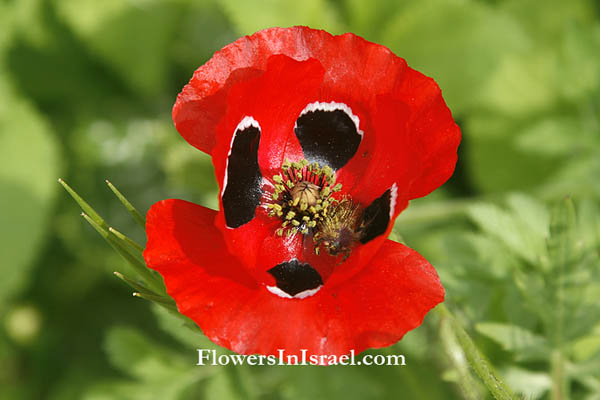
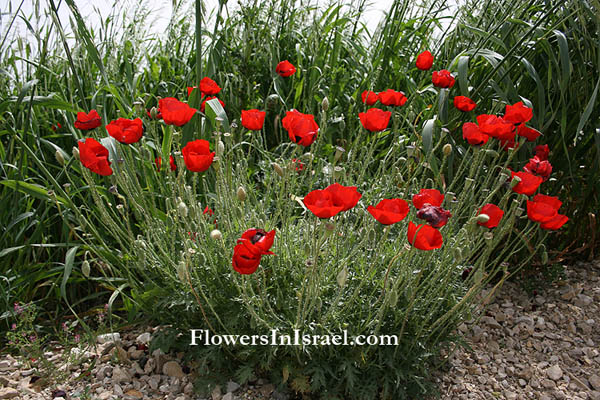
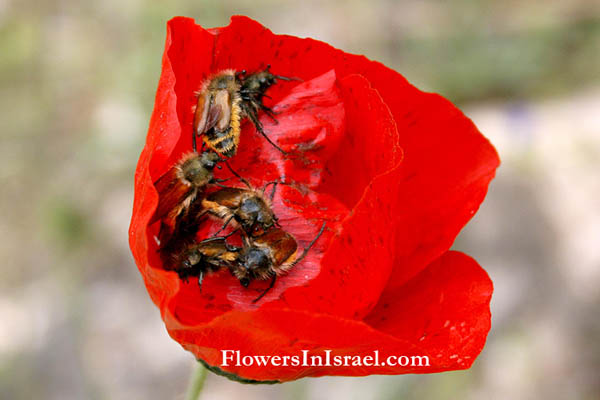
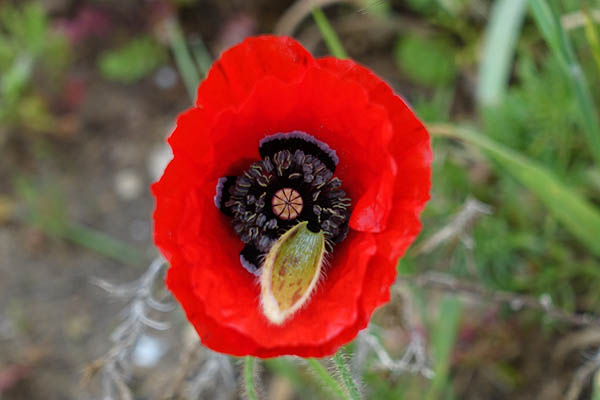
|